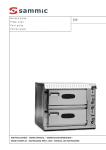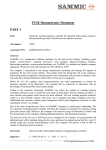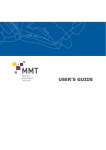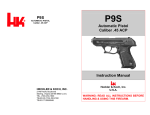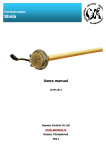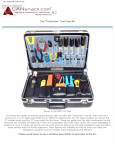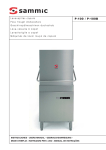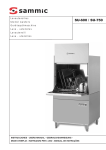Download Sammic FP Technical data
Transcript
Hornos pizza Pizza oven FP Four pizza Fornos pizza INSTRUCCIONES - USERS MANUAL - GEBRAUCHSANWEISUNG MODE D’EMPLOI - INSTRUZIONI PER L’USO - MANUAL DE INSTRUÇÕES 1. OVEN INSTALLATION Carry the oven, complete with its support, if any, to the place of installation. Make sure there is enough clearance around the appliance for proper ventilation and cleaning. The oven base and frame legs must rest on a firm, uniform and flat surface. No anchoring of the frame into the ground is required. After installing the appliance, adjust its horizontality, if necessary, by turning the M12 screws: first, place the air level longitudinally and then crosswise. The oven being level, lock the adjusting screws. close to the appliance as possible, so that the fitted cord can be plugged into an outlet. To this end, do not use extension cables. Depending on its configuration, this appliance may be supplied with either a three-pole or a four-pole power cord of appropriate length and with a yellowgreen earthing line. The free end of this cord must be connected to a EEC-unified plug, consistent with the IEC 309-2 'Plugs and Sockets for Industrial Use' standard and properly sized for the supply voltage and rated input power of the appliance as shown on the wiring diagram and in the section 'Technical Data'. 2. ELECTRIC EQUIPMENT DATA The oven electrics comprises the following devices: - One ON/OFF lever switch protected against unintentional use on the oven front. - Power relays in order to integrate the heating resistors into the circuit. - A safety transformer for supplying the auxiliary circuit with low voltage power. - RC cells fitted on the feeder of the contactor / relay and thermostat trigger circuit in order to limit surges caused by the breaking of induction and/or resistance circuits, in conformity with the Electromagnetic Compatibility (EMC) regulations for the suppression of EMI effects. - One thermostat for controlling and regulating the temperature in the cooking chamber. - One safety thermostat intended to disconnect the main power supply circuit, if necessary. - Enclosed-type heating resistors, featuring AISI 321 stainless steel external tube and a 100-mm neutral area, to reduce heat transfer to the supports. Heating resistor element made of 80-20 nichrome, with MgO ceramic insulation. - Branch and connecting terminals located inside the controls housing. - Control thermostat pilot lamps. - Wiring of the different electric devices of the appliance, with cables suitable for its intended duty and line surge limits. 3. MAINS CONNECTION Connecting the appliance to the mains and its initial start-up shall be done by an expert and qualified installer according to the technical and legal regulations in force in the user's country. Lay on a line as The specialist installer shall install the following components as may be required to comply with the applicable norms in the user's country: - One appropriate pin plug - One line breaker - One hot-wire in addition to a differential switch of adequate sensitivity for the leakage current of the resistors. The appliance must be earthed. Make the connection, as technically prescribed, bearing in mind both the cyclical phase connecting sequence and the colour code of the leads (Fig. 1): - L1 = phase - L2 = phase - L3 = phase - N/MP = Neutral - blue-coloured - PE/Earth = GREEN/YELLOW stripe sheathed wire After connecting the oven power supply protection systems, test for the differential switch efficiency with the instrument intended for this purpose. Verify that there are no combustible or other objects whatsoever inside the oven and that the oven is ready for testing. Check that the ON/OFF switch of the appliance is in the 0/OFF position. Turn the knob of the thermostat to set the temperature at an average value of about 150ºC. Put the ON/OFF switch lever in the I/ON position. Check for current consumption and correct operation of all the lamps installed. Wait for the rupture of the thermostat circuit and turn the ON/OFF switch to 0/OFF. The oven is now ready to work normally. Figura 1. 4. DESCRIPTION OF THE APPLIANCE The oven's external structure is of STAINLESS material. The front of the oven is wholly made of stainless steel. - Cooking chamber of stainless steel plate. - Oven's cooking sole made of movable and repairable refractory tiles allowing thorough cleaning of the cooking chamber. - 80-mm diameter round smoke and steam exhaust spout to be connected by means of an adequate pipe (not supplied) to the room's fume exhaust duct. This spout is special for the exhaust of hot smoke and steam developing during the cooking process. - Complete insulation of the cooking chamber by means of long-fibred rock wool quilted mat, a non-toxic and nonpolluting material. - Enclosed-type heating resistors, manufactured according to the IEC technical standards, from fine and longlasting materials. - ON/OFF switch on the front of the oven. - Thermostat for inside temperature control and regulation in a range up to 500ºC programmable with the graduated knob on the front of the oven. - One special safety thermostat protects the appliance against overheating for any reason whatsoever during its operation. - Internal lighting ON/OFF switch. - Depending on the power demand and size of the oven, the same will be prepared for either single-phase 230V or three-phase 400V, alternating current, 50 or 60Hz supply, with tolerances as per IEC 8-6 of 3/1990. - The front door includes an optimally efficient, heat-insulator Pyrex pane, except on the MINI model. - Internal lighting permits the cooking process to be supervised. - The oven door swings on hard-wearing hinges with gravity closing for easier operation. The handle of the oven door is made of heatproof material. Control of the heating resistors is by means of an integrated-type electromechanical system that includes the complete and reliable circuitry of the heating resistors with power relays as well as the auxiliary circuit controlling the thermostats, relays and lamps. Electric safeties consist in the following circuit elements, built according to the referenced standards: - Mains galvanic isolation by means of the ON/OFF switch on the front control ENGLISH 5 panel. - Fuse protection of the power relay feeding circuit. - Use of H05 RN-F type rubber covered cables and wires of sections and types suitable for the supply voltage and specific working conditions. NOTE: Protection against overcurrent and differential protection must be installed by the user upstream of the appliance power intake. minutes in order to accelerate the renewal of air inside the oven and then, close the door. During this process, do not leave the oven unattended. - At the end of the preheating phase, all the metallic and refractory components of the oven will have reached the stabilization temperature and it will be possible to use the oven in the normal way. - On subsequent uses of the oven, the above described preheating procedure is no longer required. 5. INSTRUCTIONS FOR USE OF THIS APPLIANCE 7. PERIODICAL USE OF THE OVEN With reference to Figure 2, the appliance includes the following controls: Before use, check for the following points and settings: A- Graduated knob of the oven temperature control thermostat (two thermostats per cooking chamber). B- Backlit indicators of the operation of the heating resistors in each cooking chamber (one indicator per thermostat) C- Internal lighting ON/OFF switch. D- Pyrometer for measuring the temperature in the cooking chamber. E- ON/OFF switch: in the 0/OFF position, it isolates the electric circuit of the oven from the mains; in the I/ON position, it makes the circuit. F- Cooking steam exhaust control knob. G- Oven door handle. H- Pyrex pane window for supervising food during their cooking. I- 80-mm round exhaust spout to be connected to the outside with an adequate pipe. L- Safety thermostat at the back of the oven, with built-in red-coloured reset. - Introduce the plug into the socket situated in the junction box. - Check that the oven ON/OFF switch is in the 0/OFF position. - Verify if the magnetothermal and differential switches are connected. - Put the line breaker at the current outlet in the I/ON position. - Turn the knob of the thermostat to the temperature required. - Put the oven ON/OFF switch in the I/ON position. - Wait until the selected oven temperature is reached (the light indicator turns off). - When the temperature is reached, open the door and introduce the pizzas, even directly onto the refractory sole, without any container or pan. Figura 2. The opening of the oven door results in hot air escape and the consequent quick fall of the cooking chamber temperature. It is therefore advisable to open the door only the time strictly necessary to introduce or remove the pizzas or other food products. This will save energy and prevent thermal shocks inside the cooking chamber. 6. OVEN START-UP Before cooking food in the oven, it is necessary to preheat the cooking chamber adequately. - Turn the knob of the control thermostat to set the temperature at approx. 250ºC and keep the oven working at this temperature for about one hour. - During the preheating of the oven, water steam will develop, with an unpleasant smell due to surface oxidation of the enclosed resistors. - On completion of the first cycle, all metal will have stabilised and thereafter no unpleasant smell will develop. Once the preheating time has passed by, open the front door and keep it open for a few 6 ENGLISH These ovens feature a cooking sole made of special, non-toxic food-grade refractories. Doors with inspection windows enable a visual control of the cooking of pizzas or food products, without need for opening the door. On finishing a production cycle, turn the oven off, by putting first the ON/OFF switch and then the line breaker in their 0/OFF position. 8. MAINTENANCE OF THE OVEN Operate the oven controls only in the specified sequence, to prevent damages to the devices due to misuse. For cleaning the cooking chamber, wait until the oven has completely cooled down. Remove the plug from the socket and place a 'Maintenance On' placard. The refractory tiles may be cleaned with either a water-moistened strong cloth or a steel wire brush, but detergents, solvents and chemicals whatsoever are prohibited. The very high temperature reached will automatically cause the sterilization of anything inside the oven. Hard-to-remove stains and charred remains may be scraped off with a suitable utensil, like a steel-blade spatula with insulated handle, wearing protective gloves too. The external surfaces of the oven may be cleaned with a soft sponge wetted in water and pH-neutral, chlorophosphatefree detergent with a 90% content of biodegradable surfactants. Do not use creamy detergents containing abrasives that will damage any surface irremediably. 9. INFORMATION ON INCORRECT USERELATED HAZARDS Although they are equipped with control and safety thermostats, these ovens must be attended by the user during the whole process cycle. - Keep the power cord and plug of the oven in good condition, and all the safety and circuit-breaking devices in the power supply junction box and on the oven as well. - Protect the power cord against any damage adequately and have it replaced immediately if any failure or damage, however superficial it may be, is observed. - At least once in a fortnight, check the efficiency of the 'life-saving' differential switch situated in the oven service line, by pressing the test push-button. - Neither install the oven in the open air nor under any canopy or provisional roof. - The oven should be used inside civil or industrial buildings. - Do not spray water or any combustible liquid in the interior of the oven. - Do not wash the internal or external surfaces of the appliance with water. - The oven may be operated only by people trained in the use of electrical appliances and informed of the hazards resulting from an incorrect use or, in any case, of any use that is not consistent with normal operation and the instructions contained in this handbook. - Users must be familiar with the appliance and comply with the local legal age requirements to perform their job. - Neither clean nor service the oven while it is functioning or cooling down. - A user who is suffering from any discomfort whatsoever or any unfavourable physical condition, however benign, leading to a reduction in alertness MUST NOT use these ovens and other appliances. - People under the influence of alcohol, psychotropic drugs or narcotics should not use the oven. - Before cleaning the oven, put the ON/OFF switch and the line breaker in the 0/OFF position, remove the plug from the socket and put a 'Maintenance On' placard, wait for the oven to be completely cold - this takes many hours!!! - These ovens have been designed and built, bearing in mind only their intended specific and single purpose, i.e. basically the cooking of pizza or other flour-based foods similar in nature, form and consistency such as, for instance, pies, cakes, bread and oven-baked sweets, leavened and unleavened products. - Additionally, this oven will warm up nonloose food placed in a high-rimmed container to prevent overflowing and spilling on the refractory plate, as well as the subsequent risk of a fire and contamination. - These ovens shall not be used for any purpose other than those expressly stated in this handbook. - Charred remains sticking to the walls of the oven may be removed with a noncutting utensil or a steel wire brush; in this event, wear safety gloves. - If stains on the refractory tiles are consistent and hard-to-remove with usual means, use other more specific means. - Users shall neither repair or dismantle any part of the oven nor work on the electric circuit or effect any change to the appliance. Only specialist technical staff is allowed to work on the appliance. - Do not climb or get on the oven frame and the oven itself. - Keep children away from the oven, even if it is not in operation. - Do not introduce your hands, arms or any part of your body inside the oven. - Do not move any of the refractory tiles situated in the cooking chamber; replace promptly any tile found cracked or broken. - Use the oven only for cooking pizzas and similar foods. - Keep the oven and its surrounding area clean and free from any objects. - Do not put your bare hands on any hot part of the oven, including the cooking chamber access door. - To open the door, use the heatproof handle. - In order to carry foods or trays into and out of the oven, the operator must use a baker's shovel with heatproof handle and wear safety gloves. - Do not introduce closed food containers, such as metal and non-metal cans, into the oven, since they might burst open, due to the high temperature, causing severe damage both to the oven and to the operator. ENGLISH 7 FIG. 1 Monofásica Single phase Monophasé FIG. 2 14 Trifásica Three phase Triphasé CARACTERISTICAS SPECIFICATIONS TERMOSTATO REGULABLE ADJUSTABLE THERMOSTAT Nº PIZZAS Nº PIZZAS POTENCIA LOADING DIMENSIONES CÁMARA (MM) DIMENSIONS CHAMBER (MM) - Ancho - Fondo MINI FP-4 FP-6 FP-4+4 FP-6+6 60-500ºC 60-500ºC 60-500ºC 60-500ºC 60-500ºC 4 de/of Ø25mm 4 de/of Ø30mm 6 de/of Ø30mm 8 de/of Ø30mm 12 de/of Ø30mm 2 x 3.000 W 4.400 W 6.600 W 2 x 4.400 W 2 x 6.600 W 2 cámaras/chambers 1 cámara/chamber 1 cámara/chamber 2 cámaras/chambers 2 cámaras/chambers - Width 505 610 610 610 610 - Depth 530 610 910 610 910 - Alto - Height 115 160 160 160 160 DIMENSIONES EXTERIORES (MM) EXTERNAL DIMENSIONS (MM) - Ancho - Width 785 900 900 900 900 - Fondo - Depth 720 880 1.180 880 1.180 520 460 460 770 770 80 kg 80 kg 100 kg 140 kg 190 kg - Width 770 890 890 900 900 - Depth 650 780 1.100 810 1.140 - Height 1.000 1.000 1.000 850 850 MINI FP-4 FP-6 FP-4+4 FP-6+6 - Alto - Height PESO NETO NET WEIGHT DIMENSIONES DEL SOPORTE (MM) SUPPORT DIMENSIONS (MM) - Ancho - Fondo - Alto CARACTERISTIQUES CARACTERÍSTICAS THERMOSTAT VARIABLE TERMOSTATO REGULÁVEL NBRE PIZZAS Nº PIZZAS PUISSANCE POTÊNCIA DIMENSIONS CHAMBRE (MM) DIMENSÕES CÁMARA (MM) - Largeur - Profondeur 60-500ºC 60-500ºC 60-500ºC 60-500ºC 60-500ºC 4 de Ø25mm 4 de Ø30mm 6 de Ø30mm 8 de Ø30mm 12 de Ø30mm 2 x 3.000 W 4.400 W 6.600 W 2 x 4.400 W 2 x 6.600 W 2 chambres/cámaras 1 chambre/cámara 1 chambre/cámara 2 chambres/cámaras 2 chambres/cámaras - Largura 505 610 610 610 610 - Fundo 530 610 910 610 910 - Hauteur - Altura 115 160 160 160 160 DIMENSIONS EXTÉRIEURES (MM) DIMENSÕES EXTERIORES (MM) - Largeur - Largura 785 900 900 900 900 - Profondeur - Fundo 720 880 1.180 880 1.180 520 460 460 770 770 80 kg 80 kg 100 kg 140 kg 190 kg - Largura 770 890 890 900 900 - Fundo 650 780 1.100 810 1.140 - Altura 1.000 1.000 1.000 850 850 - Hauteur - Altura POIDS NET PESO LÍQUIDO SUPPORT DIMENSIONS (MM) DIMENSÕES SUPORTE (MM) - Largeur - Profondeur - Hauteur 15 UNE-EN ISO 9001 09-01/0 ER-437/1/96 SAMMIC, S.A. (Sociedad Unipersonal) C/ Atxubiaga, 14 - 20730 AZPEITIA - www.sammic.com







